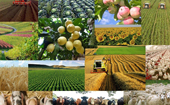2014 General Population Census
Tuesday, November 11

The census constitutes the only method to receive comprehensive information on the level of small administrative units (municipalities, the city council). “The Census 2014” will provide the latest information on the socio-economic and demographic, as well as the state of agriculture (by means of agricultural census component), including the structure of land used by the households, sown areas of annual crops, plantations of perennial crops, livestock and poultry, the number of bee families, agricultural equipment owned by the households and their application.
The first agricultural census in the history of independent Georgia was conducted in 2004. The United Nations has recommended that agricultural census in the country should be held once in every ten years.
Within the frames of 2014 agricultural census the data on agriculture should be collected on every household in Georgia, which owned or temporarily used agricultural land (cultivated or not cultivated), had cattle, poultry or bee family as of October 1, 2014 regardless of the fact any agricultural products had been produced in the reporting year or not. Specially designed questionnaire – form No. 4 “Questionnaire on Agriculture” will be used for the data collection.
Agricultural census methodology, questionnaire (form No.4) and instructions on its completion are fully based on the United Nations Food and Agriculture Organization (FAO) methodology – “2010 Agricultural Census Program”.
The data obtained from the agricultural census will assist the country authorities in proper planning of the relevant policies, as well as various agencies, farmers, business sector representatives, foreign investors and other stakeholders in the planning of their activities and different decision-making.
It is also crucial that existing Farm Register will be updated as a result of agricultural census; the Register will be used as a sampling frame for the quarterly survey of the Geostat (Sample Survey of Agricultural Farms), which, in turn, will significantly increase the quality of data calculated by these surveys, and will allow Geostat to conduct new surveys on its basis.
The data obtained from the census are confidential and are protected by “The Law of Georgia on Official Statistics” (Article 28). The data will be publicized in aggregate form only.
(Geostat.ge)
